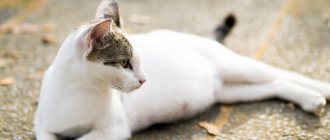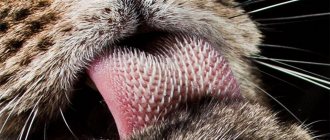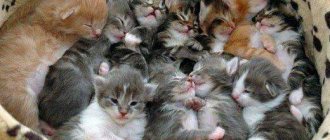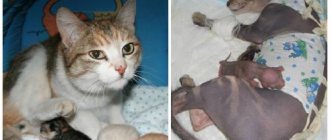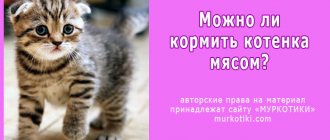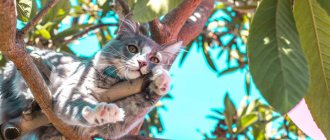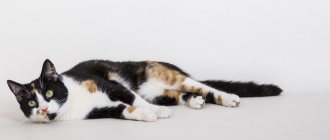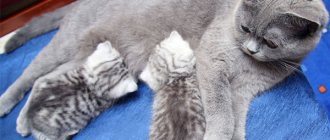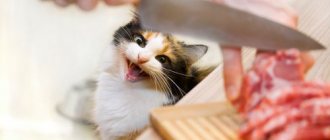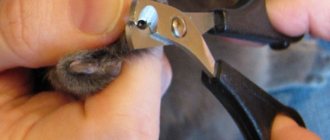To help your pet get rid of obesity, it is important to understand the reason for its development. Sometimes excess weight appears due to illness, and not due to excessive appetite. Methods of losing weight are selected strictly individually and depend on the physiological characteristics of the pet.
However, the veterinarian’s recommendations are always the same. The specialist prescribes the fat man to exercise a lot and eat right. The cat will not be able to follow these recommendations on its own, so the responsibility for maintaining a healthy lifestyle for the pet falls on the shoulders of the person. Not only its appearance, but also its life expectancy depends on this.
Why does my cat need to lose weight?
A single kilogram of excess weight already increases the risk of your pet developing serious diseases. Unfortunately, if your cat is overweight or obese, it is no longer a question of whether she will develop complications and illnesses associated with it, but when exactly they will appear and how serious they will be. Most often, excess weight is accompanied by:
- Type II diabetes – it is three times more common in obese cats than in animals of normal weight;
- Heart diseases;
- Increased risk of joint injuries;
- Osteoarthrosis (arthritis);
- High pressure;
- Some forms of cancer, especially tumors in the abdominal cavity.
Overweight and obese animals tend to live shorter lives than their slender counterparts. If a cat is overweight, it moves less and becomes less energetic and playful. The purr prefers to just lie down, and because of this it is easy to miss the first signs of illness, mistaking lethargy for “normal laziness.”
Now we are just beginning to understand the danger that extra pounds can pose to both humans and their four-legged friends.
All about obesity in cats
From the very first days of a cat's appearance in the house, the owner must provide his pet with the right diet and sufficient physical activity. Controlling the amount of food consumed is an important task, because extra pounds significantly shorten the life of a mustache.
Why does an animal become overweight?
A cat becomes fat when it eats more food than it needs. Thus, the fluffy one consumes a lot of extra calories, which it cannot expend within the apartment. During adolescence, when children and teenagers are very active and play a lot, overeating does not affect appearance. However, over the years, excessive appetite leads to an increase in body fat and ultimately to obesity.
An excellent appetite is not always the reason for weight gain. Some disorders in the body lead to the accumulation of extra pounds. Typically this is:
- diabetes mellitus type II;
- metabolic disorders;
- diseases of the cardiovascular system;
- arthrosis and arthritis;
- oncological diseases;
- high blood pressure;
- disruptions in the hormonal system;
- castration or sterilization operations performed at a late age;
- incorrectly selected diet;
- disorders in the gastrointestinal tract.
Wild and even domestic felines rarely suffer from excess weight, so they get sick less often. Domestic individuals usually lead a sedentary lifestyle, and obtain food without making any effort. A sedentary lifestyle can hardly be called healthy, which is why most fat people suffer from various ailments.
Why is obesity dangerous?
Veterinarians report that more than a third of all pet whiskers suffer from excess weight. Cats get too carried away with tasty treats and begin to gain extra pounds. The consequences of this can be dire because they provoke the development of serious health problems. The most common of them are:
- joint diseases;
- liver problems;
- pathologies of the cardiovascular system;
- high blood pressure;
- dangerous neoplasms;
- diabetes.
Excessive weight prevents your pet from leading an active lifestyle, running with other animals, and playing. The fat guy doesn’t want to get up from the couch, and even small physical activity causes him shortness of breath and discomfort. All this negatively affects the physical condition of the pet and leads to a shortening of its life.
How to determine if your pet's weight is outside the normal range
On average, the weight of an adult varies from 3 to 6 kg. Males are usually 1-2 kilograms heavier than females of the same breed.
In general, weight gain is influenced by various factors. The main ones include gender and breed, type of feeding, heredity, and general physical condition. For example, the normal weight of large species can reach 8-10 kg. This is considered the norm.
Signs that your pet is overeating should be cause for concern. His stomach begins to sag and his waist disappears. If you pick up the animal, you can easily feel the fat layer. But the ribs, pelvic bones and spine, on the contrary, cannot be found by touch.
Obesity changes the appearance of the mustache and leaves it with a lot of inconvenience. The fat man's gait changes, he begins to waddle and loses his former grace.
Where to begin?
In theory, it's simple: consume fewer calories, burn more, and this will lead to weight loss. Unfortunately, in reality everything is somewhat more complicated. Never put your cat on a diet without consulting your veterinarian.
Physiologically, cats are different from humans and dogs, and a two-day fast can lead to the development of a fatal disease known as hepatic lipidosis (or fatty liver disease). Your cat should first be seen by a veterinarian, who may order additional tests to make sure there are no underlying medical conditions or other barriers to weight loss. If everything is fine, you can already think about how to help your cat lose weight.
Reasons for the need to lose weight
The reasons why an overly plump cat needs to lose weight are associated with the harm that excess weight causes to the animal’s body. Due to the abundance of fat, the following occurs:
- deterioration of the functions of internal organs, primarily the liver, heart, blood vessels;
- the occurrence of type 2 diabetes;
- problems with movement, muscle atrophy;
- deformation of joints under the influence of excessive load, development of arthritis and arthrosis;
- lack of oxygen due to heart failure.
Obesity can provoke the development of cancer. All these factors dramatically reduce the time and quality of life of a pet. And communication with the owner comes down to petting: the cat has no desire to play, becomes sleepy, lethargic, and its hunting instincts fade. In a private home, this can lead to the appearance and reproduction of rodents.
Excess weight prevents the animal from moving normally
How to feed a cat to make it lose weight?
To answer this question, your veterinarian will need to examine your cat and, based on her body type and size, determine what weight would be ideal for her. Specially developed formulas and graphs will help him with this, thanks to which he can also calculate the cat’s calorie needs per day in order to achieve the desired weight without harm to health.
On average, an adult domestic cat should weigh 3.6 – 4.4 kg. Depending on the degree of obesity, your doctor may recommend first achieving an intermediate weight, which is slightly larger than your ideal weight. For example, if your cat weighs around 8kg, her ideal weight would be 4.4 – 5.5kg, but a more realistic target would be an intermediate weight of 6.8kg. Once it has been achieved, it is necessary to re-evaluate the pet’s condition and determine whether the cat should lose weight further.
Games are the best exercise
ravepad.com
The easiest way to help your cat maintain a healthy lifestyle is to play with him. Even a few minutes a day will help.
Try to interest the fat man in new toys and see how he himself demands activity from you! You don't have to spend all your savings; a homemade mouse or an inexpensive laser pointer will also work.
It's even easier to get a second cat and see how busy they are with each other. This is a great option for people who spend most of the day at work.
How to calculate your cat's calorie needs
The weight loss formula for cats is based on the cat's resting energy requirement (the number of calories a cat needs when not physically active, or PEED), which is calculated as follows:
- Method: PEPP in kcal/day = 70 x (ideal weight in kg) x by ¾;
- Method: PEPP in kcal/day = 30 x (total weight in kilograms) + 70.
To lose weight, a cat must receive 80% of the PEPP (multiply the PEPP by 0.8). In order not to waste time on calculations, you can use the table:
| Ideal Weight: lbs (kg) | Calories that make up 80% of your daily nutritional intake |
| 8 (3,6) | 180 |
| 10 (4,5) | 210 |
| 12 (5,4) | 230 |
Please note: These are general guidelines and cannot replace the advice of your veterinarian. If your cat is unable to lose weight by consuming the specified amount of calories, it should be reduced.
Table: comparative characteristics of dietary feeds of various brands
| Name of food | Class | View | Flavors | Peculiarities | Price |
| Eukanuba Adult Sterilized Weight Control Chicken | Superpremium | Dry | Chicken | Designed for sterilized and neutered male cats |
|
| Hill's Prescription Diet Metabolic Weight Management | Superpremium | Dry | Chicken | Allows you to maintain optimal weight |
|
| Hill's Prescription Diet Metabolic + Urinary Weight Care | Superpremium | Dry | Chicken, turkey | Also used for cats with urinary tract diseases |
|
| Hill's Prescription Diet i/d Digestive Care (jelly) | Superpremium | Wet | Chicken | Helps maintain a healthy digestive tract |
|
| Hill's Prescription Diet w/d Digestive/Weight Management | Superpremium | Dry | Chicken | Helps normalize weight in diabetic cats |
|
| Hill's Prescription Diet w/d Digestive/Weight Management (jelly) | Superpremium | Wet | Chicken | Better absorbed by the pet's stomach |
|
| Royal Canin Satiety Weight Management SAT34 | Superpremium | Dry | Chicken, poultry | Can be used for diabetes and urolithiasis |
|
| Royal Canin Neutered Adult Maintenance | Superpremium | Wet | Chicken, pork, poultry, liver | Suitable for sterilized animals in the postoperative period |
|
| Pro Plan Veterinary Diets Feline OM Obesity (Overweight) Management dry | Premium | Dry | Chicken, poultry | Used for adult cats |
|
| Farmina Vet Life Natural Diet Cat Obesity | Premium | Dry | Chicken, pork, poultry | Prevents muscle loss | 2 kg - 1709 rub. |
| Royal Canin Satiety Weight Management (jelly) | Superpremium | Wet | Chicken | Suitable for pets with diabetes |
|
| Purina Pro Plan Veterinary Diets OM pouches | Superpremium | Wet | Chicken | Helps maintain weight |
|
| Happy Cat Adipositas | Superpremium | Dry | Chicken, poultry | Also used for cats with liver disease |
|
| Brit VDC Obesity | Superpremium | Dry | Chicken | Suitable for British cats, grain free | 2 kg - 1240 rub. |
| Forza10 Active Line | Superpremium | Dry | Fish | Consists of heart-shaped granules | 454 g - 470 rub. |
| Enova Breeder Cat Light Indoor | Superpremium | Dry | Chicken, rice | Can be used to feed cats over 7 years of age | 10 kg - 6300 rub. |
| Bosch Sanabelle Light for cats prone to obesity | Superpremium | Dry | Bird | Provides quick satiety due to the large amount of dietary fiber | 2 kg - 1300 rub. |
| Barking Heads Adult Fat Cat Slim | Holistic | Dry | Chicken, salmon | Suitable for pets with sensitive stomachs |
|
| 1st Choice Weight Control | Superpremium | Dry | Chicken | Designed for adult animals | 5.5 kg - 2600 rub. |
Photo gallery: examples of dietary foods
Hill's Prescription Diet i/d Digestive Care stimulates the stomach and intestines Purina Pro Plan Veterinary Diets OM pouches improves digestion Royal Canin Satiety Weight Management comes in jelly form Forza10 Active Line has an original heart-shaped granule shape Happy Cat Adipositas helps reduce weight in cats with disease liver Hill's Prescription Diet w/d Digestive/Weight Management is used for cats with diabetes Hill's Prescription Diet Metabolic Weight Management helps maintain proper body weight Pro Plan Veterinary Diets Feline OM Obesity allows you to quickly lose excess weight
Which food to choose?
Since cats are obligate carnivores, human diets are not suitable for them. A diet high in protein and low in carbohydrates should help your cat lose weight. This is exactly the food you need to choose.
The amount of food needed to provide the required amount of calories depends on its calorie content. Usually the calorie content of the food is indicated on the packaging, and a specialist will explain to you what portions it should be given.
Usually, a cat loses weight most effectively by receiving dietary canned or dry food several times a day. You can’t leave it in a bowl while losing weight, because regular meals are healthier than constant snacking throughout the day. How to make a cat lose weight if it always has the opportunity to crunch on something out of boredom or for pleasure?
It is very important to learn how to count calories and measure the prescribed amount of food. If there is too much food, the animal will not lose weight, and if there is too little, it will begin to starve, which, as already mentioned, is very dangerous for cats.
What diet should I put my cat on if his weight exceeds the norm?
On the one hand, if the cat does not go outside, and the refrigerator is tightly closed, the question “how to lose weight for a cat” can be solved very simply: give less food
. A cat, unlike a human, will not go off the diet, and he will not be in danger of raiding the contents of the refrigerator.
On the other hand, a malnourished hungry cat can so fray the nerves of everyone in the family that everyone will become sorry and start feeding the cat three times as much!
Therefore, the correct solution to the problem of “how to lose weight for a cat” is not to reduce the portions, but to change their composition
.
If the cat is “artificial” - that is, eats ready-made food - consult a veterinarian so that he can recommend a special medicinal food for obesity
. Portions of “drying” should be gradually reduced, divided into a larger number of feedings, so that the cat does not feel hungry.
Sometimes there is advice to switch your cat to natural food.
The veterinarian will also determine what is causing the obesity and whether additional treatment is required.
– since this is not always a consequence of simple overeating, the risk of hormonal changes in the animal’s body cannot be excluded.
If you feed your cat exclusively natural food, then make sure that there is more fiber
– boiled vegetables, cereals. Eliminate fatty meats and replace them with lean fish and chicken.
And very important - no bounty from the human table
!
No “one ring of sausage so you don’t meow”, no sprats, herring heads, etc.! Also, make sure that the trash can is taken out in a timely manner - cats, when on a diet, lose all notions of nobility and are not averse to being homeless in the trash...
How long does it take to train a cat to go on a diet?
Give your cat a week or two to get used to the new diet. First, mix ¼ of the new food with ¾ of the usual food for 2 to 4 days. Then increase the amount of new food to half, and in the last 3 to 5 days before the final transition to the new diet - to ¾.
To improve palatability, you can heat the food and add flavoring additives, for example, based on fish oil containing Omega-3 fatty acids.
If your cat refuses a new diet, or if you have any questions while introducing her to a new food, do not hesitate to contact your veterinarian for advice.
Feeding Obese Cats Natural Products
If your animal has gained excess weight on a natural diet, you should also reconsider its diet. Don't forget that a healthy adult cat's diet should include proteins and fats of animal origin. You shouldn’t suddenly switch your furry pet to plant foods or greatly reduce portion sizes: this will only provoke unnecessary stress. Veterinarians recommend using the following products to feed overweight cats:
- Meat, offal and fish contain the required amount of protein and essential amino acids. Lean beef, rabbit, chicken or turkey are suitable for dietary nutrition. Of the by-products, preference should be given to hearts and liver. Meat should be served boiled or fresh frozen to destroy helminths. For dietary nutrition, steamed sea fish (trout, salmon) is mainly used.
- Milk based products. Kefir, cottage cheese, fermented baked milk, goat cheese, bifidok are sources of calcium and easily digestible protein, so they must be included in the cat’s diet. Please note that their fat content should not exceed 2–5%.
- Porridge and cereals. The fiber they contain provides satiety and acts as a natural scrub for the intestines, removing toxins. Cereals that are healthy for cats include rolled oats, brown rice, and millet. They need to be boiled in water or chicken broth.
- Greens and vegetables. They are used as an additive to cereals or meat: they should be boiled and ground in a blender. The best foods for feeding cats are spinach, celery, zucchini, squash, green beans, carrots, broccoli, and cauliflower.
Photo gallery: healthy foods for pets
By-products contain the required amount of protein
Dairy products are rich in calcium
Vegetables are the best source of vitamins and minerals
It is harmful to feed cats from the home table: our food contains a large amount of salt and various additives that negatively affect their health. Such a diet contributes to the development of obesity and other dangerous diseases. Veterinarians strictly prohibit giving overweight cats the following foods:
- sausage, frankfurters, small sausages;
- semi-finished products (cutlets, zrazy, dumplings);
- butter;
- chicken skin and fat from meat;
- bones;
- processed cheese;
- ice cream;
- sweet yoghurts and curds.
How to get your cat to move more?
In an ideal world, you could go for a morning run with her, but unfortunately, we don't live in an ideal world. Making a cat lose weight by exercising with it is not just difficult - it goes against the very nature of this animal.
Sprinters, not marathon runners
Cats are not adapted to the lifestyle of scavengers or pack hunters, like humans and dogs. They are ambush predators that expend very little energy searching for prey and rarely venture beyond their territory. Having discovered prey, the cat launches into a very intense and short chase.
Most wild cats chase prey at top speed for no more than a minute. When the chase is over, the cat requires many hours of recovery for the next hunt.
Domestic cats are smaller versions of wild cats. We can take our dog with us for a walk or jog, but among cats there are only a few who love active recreation. Cats prefer short distances rather than marathons. You will have to call on all your ingenuity to help make the mustachioed hulks move more.
Useful ideas
Place the food bowl in different places, such as at the top or bottom of the stairs, and try to place it so that the cat has to travel a certain distance before reaching the food. Cats are smart: having realized that the bowl is now at the top, they themselves will go upstairs more often.
Place the food bowl as far as possible from the cat's preferred areas. Many obese cats sleep and rest near a bowl so they don't have to walk far to get food.
Buy food container toys - they are usually shaped like a ball that the cat rolls to get the treat. You need to put a certain amount of dry food inside these interactive toys, and the cat will have to work hard to get it.
Take time to play with your cat, use feather teasers, laser pointers, paper or foil balls - anything that your cat will be interested in catching. Try playing with your cat for ten minutes twice a day. This can be done while eating, watching TV or even reading.
There are many moving and squeaking toys that may interest your cat. Cats love variety, and a toy that the animal liked today may become boring tomorrow.
Physical activity
A cat cannot be forced to lose weight like a dog through jogging and sports exercises. Therefore, the owner has to invent different ways to increase the physical activity of an animal with extra pounds.
How to make a cat move?
Regular physical activity will help reduce fat accumulation in your home couch potato. It’s good if they have the opportunity to go outside - in this case it will be easier to get rid of excess weight. You can purchase a special harness and go for walks with your cat.
It wouldn’t hurt to tease your baby, encouraging him to run after a ball or his favorite toy. It is convenient to use special weight-loss feeders with grooves for feeding - they will force the fluffy to work hard before eating the yummy food. You can make your own bowl suitable for these purposes by cutting out a window in a plastic bottle. The couch potato will roll it around to get to the food.
“Exercises” for mustaches
Experienced cat owners have long known how to lose weight for a castrated cat at home. They recommend placing food bowls in places where the animal can only get through small barriers. For example, you can raise the plate higher on the platform or place an obstacle in front of it that needs to be climbed or overcome. For example, you can place a bowl of food on the top step of the stairs.
It will be useful to purchase/make a running wheel or special slides. Your four-legged friend will train on them, gradually losing extra pounds.
The simplest and most accessible “exercise” for a mustache is to connect the front and rear legs together and spread them apart - this exercise is performed by the hands of the owner.
What not to do
Cats cannot live the same way as dogs or people. Representatives of the cat family are predators that prefer to sit in ambush and wait. Because of this, they spend a small amount of energy and rarely leave the territory.
An animal should not be forced to run at maximum speed for more than one minute. The pet does not recover well after long distances, and this can harm the health of the furry. It is better to drive it little by little, but often.
How often should you re-weigh?
Once you have developed a plan for how to lose weight for a cat in such and such a time, with your help, it is very important to understand whether it is effective.
Each cat is unique, and the recommended diet may require several adjustments before you see results. On average, a cat should be weighed every month until it reaches its ideal weight. If there is no result within a month (weight loss of about half a kilo), the program needs to be adjusted. Sometimes even a small change is enough.
Weight loss program for fat cats
It is developed by a veterinarian if the cat does not need treatment for a systemic disease. In this case, the main directions of the weight loss plan will be a gradual change in diet and increased physical activity. Usually, doctors determine the cat’s ideal weight and an intermediate weight to which he first needs to lose weight. After all, rapid loss of body weight will only harm the health of the purr.
Examination by a veterinarian
Dietary recommendations for cats
Most often, veterinarians recommend that owners of fat cats change their pet’s food or reduce portions. You need to act gradually so as not to cause stress in the animal. Doctors advise adding a quarter of the new food to the main food in the first days, then gradually increasing its ratio in the bowl.
How long it takes to accustom a cat to a diet depends on how quickly it gets used to healthy food, but on average it takes a couple of weeks.
After the cat completely switches to the new diet, it should be weighed every week to record whether there are any positive changes. If at first the weight decreased, but then the process stalled, this is normal. Continue to feed your pet according to the new scheme, and when the “plateau” is overcome, the weight will go down again. But if there are no results within a month, you need to adjust your diet together with your veterinarian.
The new food needs to be slowly mixed with the old one so that the animal gets used to it.
Feeding frequency
Sometimes, for a cat to return to its previous form, it is enough to change its diet: remove bowls of food from constant free access. Domestic cats need to be given food four times a day in small portions - the size of an average mouse.
You will have to get used to the new diet
Reducing caloric intake
Portions should be reduced gradually so that the animal does not suffer from stress. If you are wondering how to make a fat cat lose weight, you cannot keep it on a starvation diet - it will get sick. The maximum that an animal can lose is 2% of its own weight. To achieve this, the overall diet is reduced by an average of 15% or food with a reduced calorie content is chosen. In the latter case, you can focus on average indicators for how much you need to reduce caloric intake if the cat moves very little.
Low-calorie food for adult cats
The volume of breakfast, lunch and dinner is gradually reduced
Table 1. Daily kilocalorie intake to achieve the cat's ideal weight.
| Required body weight, kg | Calorie content of food per day, Kcal |
| 3,5 | 180 |
| 4,5 | 210 |
| 5,5 | 230 |
For larger cats, the average caloric intake of a diet that will lead to weight loss can be calculated using the formula: 80%x(70x(required weight)x¾). This calculation is an average; figures may vary depending on the breed.
Correct menu
Natural food for small cats is birds and mice. That is, almost completely protein. And dry food usually contains a lot of carbohydrates from grains. This contributes to weight gain and the development of diabetes. In order for a cat to lose weight, it needs to be fed either a ready-made high-protein, expensive formula, or an analogue of natural food.
In an optimal cat menu, proteins, fats and carbohydrates should be approximately in the following proportion: 5:3:2.
But when switching to a diet close to natural, you cannot give the cat only meat. But it must be there. Preferably low-fat varieties: turkey, chicken, rabbit. Additionally, the diet includes:
- low-fat boiled fish;
- cereals without steam treatment;
- low-fat dairy products.
Be sure to supplement your diet with vitamins as recommended by your veterinarian. You should not salt your cat's food. Your pet should have fresh water available at all times.
Protein foods are the basis of the diet
Healthy “snacks”
If you want to please your pet and reward him for good behavior, you should not treat him with store-bought treats or sausage. Such products contain additives and flavorings that are not very healthy and increase appetite. And some store-bought “snacks” are even addictive. It is better to treat your pet with a slice of boiled chicken or fish without spices.
Cats should not eat human food, especially if they are losing weight.
Increase physical activity
Cats are predatory animals, but they hunt from ambush and are not inclined to travel long distances to chase or track prey. And at home, when there is no need to hunt, they become completely lazy. They spend most of the day in blissful bliss and gain extra pounds.
Important! Physical activity is extremely important for effective weight loss - it speeds up calorie burning and metabolism.
Cat "fitness"
It is incredibly difficult to distract a fat cat from his nap. But underneath the layer of fat lies a wild and brave hunter. You just need to remind your pet about this. The main way to get your cat to move more is to play with it. Various devices help with this:
- laser pointers;
- interactive mice;
- various balls;
- squeaker toys.
Even a piece of paper on a string or a simple ball can interest a cat. But you will have to constantly come up with something new - cats do not tolerate monotony, and one single ball will quickly get boring.
Kids are the best “trainers” of fat cats
The best “fitness trainer” for a cat is a preschooler. The baby will be happy to bother the sloth and come up with a variety of fun games.
Additional loads
There are a few more tricks on how to make an overweight cat lose weight:
- Placing a bowl of food away from its usual place so that the cat still has to take a walk “to hunt.” In this case, the bowl must be removed after eating, and at the next meal, moved to a neighboring place a little further away. Otherwise, the fat man will settle down to rest next to the feeding area.
- Buying an unusual feeder so that the sloth has to sweat before getting food. But it should not be an automatic feeder in which food is always available.
- Purchasing toys that you can put dry food inside. It is also quite difficult to get.
Don't let your sloth relax near your bowl
You can come up with any tricks to make a fat cat move and lose weight. There are even special animal gyms where cats lose weight under the guidance of trainers. If there is one nearby and you have the means, why not buy your pet a subscription.
What to do if your cat is constantly begging for food?
When cats wake us up at four in the morning, demanding food, screaming like crazy, or non-stop poking their foreheads at their owner, we give up. The cats have trained us well, they know very well which buttons to press to get what they want! Here are some tips for pacifying annoying Persians or irrepressible Siamese:
- Do not use automatic feeders. It is quite obvious that the automatic feeder for the fat tailed man is a machine filled to the brim with candies.
- Pet your cat or play with her when she begs for food. Many cats perceive food as equivalent to their owner's attention, and you may find over time that play replaces the cat's meal.
- Feed your animal in smaller portions, but more often, so you can provide a late dinner for a cat who likes to wake you up in the morning. Divide your total calories into four to six small portions. The most important thing is not to give your cat food in excess of the prescribed amount.
- If the bowl is empty and the cat won't calm down, put a couple of pieces of food in the bowl. A couple of pieces, not a handful.
- Offer your cat fresh water instead of food. When your cat is persistently staring at an empty bowl, a sip of fresh, cold water can curb her appetite.
Start working!
lacarmina.com
You can't do without exercise and, of course, you won't be able to get your cat on a treadmill. Start small: buy a scratching post and explain how to use it.
This may seem like a small thing, but it's not. For a lazy cat, accustomed to lounging between the sofa, bowl and litter box, any activity will be important.
How to feed other cats if only one needs to lose weight?
You may find a better solution to the problem, but here are some tips to get you started:
- Feeding cats separately is the ideal solution for such cases. Give your losing cat some diet food in one room and feed the rest in another. When the time allotted for a meal is over - usually from fifteen minutes to half an hour - remove what the animals did not eat until the next feeding.
- Feed a cat that is not overweight at the top, where it is more difficult for an overweight cat to climb.
- Never leave food out in the open unattended. This way you won’t be able to control who eats what and when!
Tricks and life hacks
During the process of losing weight, it is difficult not only for a well-fed friend, but also for the owner himself and his family members. The animal's mood changes, it often gets irritated, behaves aggressively, and persistently asks for food. Advice from experienced owners will help you get through this difficult period.
Healthy treats
Feeding a friend prone to obesity from the host's table is strictly contraindicated. As healthy treats, you can offer sticks specially made for this purpose; they are made from low-fat meat products - such straws are sold in any pet store.
Pieces of chicken or fish are also suitable for encouragement. But you shouldn’t pamper your fluffy often – this can ruin his appetite and lead to gluttony.
Weaning off begging
Begging for food, the cat looks pitifully at the person. But the owner and family members should not succumb to provocations. Feeding will not be a manifestation of care and love for your mustachioed friend.
The animal should be weaned from begging. The best way to do this is to distract his attention. You can talk to your pet, pet him or offer him a toy. If he doesn't calm down, you should pour him fresh water.
What to do if there are several animals
If there are several pets in the house, and only one needs to lose weight, then difficulties arise. The main way to provide a fat baby with dietary nutrition and prevent him from eating from other bowls is separate feeding. Food should be placed in different rooms or a bowl of thin pets should be placed on the upper steps, where it is more difficult for a well-fed companion to reach. The main thing is not to leave plates of food unattended.
How long will my cat have to be on the diet?
Most cats reach their ideal weight within 6 to 8 months. If the process is delayed, then something needs to be changed. Healthy weight loss is about a pound per month. Some cats take longer, while others lose weight faster.
For most cats, the secret to effective weight loss is attentive and responsible owners. Cats don't understand that obesity is killing them. We, as good owners, must protect them from danger and, of course, not unwittingly contribute to their development of serious illnesses or their premature death.
Only by working closely with your veterinarian and your entire family can you ensure that your cat remains fit and healthy.
The recommendations are based on the work of veterinarian Ernest Ward.
Risk factors for being overweight
Most often, excess weight occurs due to an unbalanced diet and non-compliance with feeding rules. But sometimes a cat gains extra pounds due to illness or hormonal imbalance. Therefore, an overweight pet must be shown to a veterinarian to accurately determine the cause of obesity. Based on the test results, the doctor will develop a treatment regimen or an acceptable diet.
Britons are the most likely to be overweight
There are a number of reasons that provoke extra pounds in cats:
- Regular overeating. A cat's appetite is always slightly larger than the portions required for health. If there is no control and food is always freely available, the animal will constantly overeat and gain weight.
- Low physical activity. May be associated with joint diseases or be the result of a phlegmatic temperament.
- Genetics. If the animal's ancestors were overweight, there is a high probability that the tendency to be overweight will be inherited. It can also be a feature of the breed, for example, among the British.
- Castration or sterilization. Such operations help reduce metabolism and change hormonal levels.
- Age-related changes. Older cats prefer to nap in a cozy place most of the time, and their metabolism is slower. All this leads to an increase in body weight due to fat.
Preventing excess weight for spayed or neutered pets
Often cats become fat due to genetic defects. They may be associated with problems in the ovaries, pancreas and thyroid glands.
Sometimes failures occur during pregnancy and childbirth. Typically, dysfunctions are manifested not only by the accumulation of fat on the sides, but also by hair loss or dullness, and loss of elasticity.
Young cats are rarely fat
To return your pet to its former shape, you need to force him to lose weight so that weight loss does not cause deterioration in health. The important thing to remember here is that obesity does not happen suddenly. This is a gradual process, usually starting in mature or neutered animals. Vigorous feline youth are rarely fat. Particular attention should be paid to your pet's nutritional rules in winter, when activity decreases.

